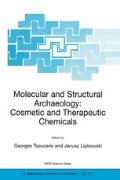Abstract
Since remote times, decoration and care for the body have driven the search for a variety of materials possessing decorative, and sometimes pharmaceutical properties. Examination of human representations in prehistory and analysis of archaeological remains [1] have made it possible to bring together tenuous data relating to body art more than ten thousand years ago. The red and yellow pigments based on iron oxide, and black pigments based on carbon or manganese oxide, were ground and mixed to provide a range of tints useful in the ritual decoration of the body with tattoos or painted designs.
Access this chapter
Tax calculation will be finalised at checkout
Purchases are for personal use only
Preview
Unable to display preview. Download preview PDF.
References
Walter P. (1995) — La peinture des femmes préhistoriques, inLa Dame de Brassempouy E.R.AU.L.74,p. 259.
Troy L. (1993) — Paintinf the Eye of Horus.Hommage à Jean Leclant Bull. D’Egyptologie 106/1,pp. 351–360.
Vandier d’Abbadie, J. (1972) — Catalogue des objets de toilette égyptiens du Musée du Louvre, Réunion des Musées Nationaux, Paris
Martinetto, P., Anne, M., Dooryhée, E., Walter, P. and Tsoucaris, G. (2000) A synchrotron X-ray diffraction study of Egyptian cosmetics, in D. C. Creagh and D. A. Bradley (eds.)Radiation in Art and ArcheometryElsevier, Amsterdam, pp. 297–316.
Martinetto P. (2000) Etude cristallographique des préparations cosmétiques de l’Egypte ancienne. PhD thesis, Grenoble University, France, 260 p.
Dooryhee E. (2003), this volume.
Walter, P., Martinetto, P., Tsoucaris, G., BréniauxR.,Lefebvre, M.A., Richard, G., Talabot, J. and Dooryhée E. (1999b) Making make-up in Ancient EgyptNature 397,483–484.
Zehnacker, H. (1983) — Pline l’Ancien Histoire naturelle livre XXXIII. Ed. Les Belles Lettres, Paris.
Wellman, M. (1958) — Dioscoridis Pedanii De Materia Medica libri quinque. Ed. Weidmannsche Verlagsbuchhandlung, Vienna.
Bardinet T. (1995) —Les papyrus médicaux de l’Egypte pharaoniqueédition Fayard, Paris, 591 p.
Lucas, A., HarrisJ.R.(1963) —Ancient Egyptian Materials and Industries.Ed. Edward Arnold Ldt., London, pp. 80–97.
Nunn J.F. (1996) — Ancient Egyptian Medecine. British Museum Press, London, 240 p.
Ungar T., Anne M. DooryhéeE.Martinetto P., Ribarik G., Walter P. (2002) — Tracing back the fabrication procedures of ancient Egyptian makeups using the Fourier coefficients in whole profile fitting of ab-initio physical functions.J. of Applied Physics91–4, pp. 91–4.
Martinetto P., Castaing J., Walter P., Penhoud P., Veyssière P. (2002) — Structure of milled galena (PbS) particules as a result of grinding: observations by electron microscopy.J. Material Research17–7, pp. 1601–1611.
Besnard M., Cotte M., Puisieux F., Tchoreloff P., Tsoucaris G., Walter P.-Recherches physico-chimiques à la frontière entre la pharmacie et l’archéologie. Numéro spécial de la Lettre des Sciences chimiques « Pharmacie et archéologie », CNRS, 2003
Author information
Authors and Affiliations
Editor information
Editors and Affiliations
Rights and permissions
Copyright information
© 2003 Springer Science+Business Media Dordrecht
About this paper
Cite this paper
Walter, P. (2003). Inventing A Science of Make-Up. In: Tsoucaris, G., Lipkowski, J. (eds) Molecular and Structural Archaeology: Cosmetic and Therapeutic Chemicals. NATO ASI Series, vol 117. Springer, Dordrecht. https://doi.org/10.1007/978-94-010-0193-9_1
Download citation
DOI: https://doi.org/10.1007/978-94-010-0193-9_1
Publisher Name: Springer, Dordrecht
Print ISBN: 978-1-4020-1499-4
Online ISBN: 978-94-010-0193-9
eBook Packages: Springer Book Archive

